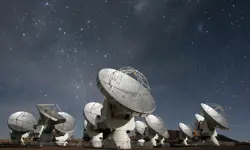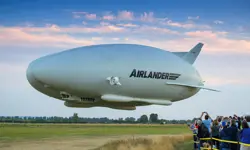
Q&A: Abigail Berhane, aerospace engineering researcher
💬 Shini says...
Ingenia 100 guest editor Dr Shini Somara tells us her thoughts
Those who work hard and are committed to overcoming barriers and obstacles to succeed are inspiring to me. Individuals with determination and optimism are my friends. Abigail is one such person, who has diligently persevered with her PhD despite being from an underrepresented group in aerodynamic engineering. Her passion for her area of research and focus on her thesis is to be admired.

`
Why did you first become interested in science/engineering/STEM?
Physics was always my favourite subject in school, and my fascination with space only deepened my interest. I admire physicists like Brian Cox and Neil deGrasse Tyson, who have a talent for making physics both fun and accessible.
As a child, I enjoyed sci-fi films such as The Core and the Back to the Future trilogy. Watching The Core for the first time, I immediately thought, “I would want to be the scientist who detects something is wrong and the one who gets sent on the mission!” The idea of time travel in Back to the Future was also incredibly exciting to me.
My father, a pharmacologist, also played a crucial role in fostering my love for physics. His encouragement was key in my decision to delve more into this fascinating field.

Dr Shini Somara visited Abigail in her lab at the University of Cambridge
Did anything particular inspire you into engineering?
In 2014, I had the incredible opportunity, as a Year 11 student, to join a sixth-form trip to CERN in Geneva, Switzerland, to visit the Large Hadron Collider. During our visit, the collider was under maintenance, allowing us to safely explore the experimental areas. Witnessing the engineers at work was truly inspiring.
How did you get to where you are now?
During my time at the University of Sussex, I found myself really enjoying thermal power cycles. My dissertation was all about designing a casing recirculation treatment for a turbocharger compressor, and thanks to Professor Martin Rose and Dr Vasudevan Kanjirakkad, I discovered a real passion for turbomachinery. While studying, I also worked at Southern Water as a data analyst, keeping track of the efficiencies of various water pumps.
I decided to dive deeper and pursue a PhD in turbomachinery aerodynamics. That’s when I came across the Centre for Doctoral Training (CDT) MRes and PhD programme in future propulsion and power, which is a collaboration between the universities of Cambridge (Whittle Laboratory), Oxford (Osney Laboratory), Loughborough (National Centre for Combustion and Aerothermal Technology), and industry partners.
When I visited the Whittle lab during my application process, I met Dr Masha Folk, who has been an amazing mentor ever since. She invited me to the CDT Women in Aerospace dinner at Oxford in 2019, where I got to meet some incredible women in the field. After completing the MRes, I started my PhD in 2020, focusing on how surface roughness affects the aerodynamic performance of aero-engine turbine blades.
Since then, I’ve been lucky enough to receive the Amelia Earhart Fellowship, the 2023 Freeman Award for my contributions to the lab, and the 2024 Cambridge Society for the Application of Research PhD Student Award. Most recently, in June 2024, I presented my research at the American Society for Mechanical Engineers Turbomachinery Conference.
What has been your biggest achievement to date?
During my time at Cambridge, I have won awards for my contributions to aerospace engineering, which have all exceeded my expectations of what I could achieve academically. Being the only Black research student at my lab currently and, most probably, the first Black woman to get a PhD from the Whittle lab, I have had to overcome barriers that many underrepresented people face. I am proud to have made a dent, highlighted issues and set an example for other underrepresented people in advanced engineering research in the future.
What is your favourite thing about being an engineer?
I enjoy applying rigorous analysis to complex problems such as surface topography friction and seeing their impact in wider contexts. I really like using novel computational and experimental techniques to understand complex flows in turbomachines. I also want to continue supporting the next generation of diverse engineers. This support is crucial in advancing sustainable solutions. I also want to develop my career in aerospace engineering research because, ultimately, I feel that protecting our environment through my area of expertise is the most personally fulfilling.
What does a typical day involve for you?
My daily routine depends on whether I have experiments lined up. If I do, I start with a workout at home or at the gym, then head to the lab by 10am for a three-hour cycle of wind tunnel experiments. After lunch, I spend another three to six hours collecting data, depending on how things are going. During this time, I might also do some 3D printing and prep content for the undergrads I supervise.
Once I’m done in the lab, I go home for dinner. My evenings are usually spent processing data, planning the next day’s experiments, and making predictions about the results. Now that I’m writing my thesis, I have a lot more flexibility in my schedule, which is a nice change.
Quick-fire facts
Age:
26
Qualifications:
BEng in mechanical engineering; Master of Research (MRes) in future propulsion and power; PhD in future propulsion and power
Biggest engineering inspiration:
American mathematician and rocket scientist, Mary Jackson
Most-used technology:
Polyjet 3D printer
Three words that describe you:
Curious, passionate and empathetic
What would be your advice to young people looking to pursue a career in engineering?
Work hard and stay curious. Engineering is an incredibly exciting field. If you’re a young woman aspiring to enter engineering, remember you don’t have to change who you are to fit in. I’ve always embraced my ‘girly’ side, and I still do. Outside of engineering, I’m passionate about textiles and fashion. Diversity is crucial in engineering; it drives innovative solutions to some of our toughest challenges, like climate change.
Academically, engineering combines maths, physics, design and technology, and computer science. Mathematics is all about practice!
Don’t get discouraged if it’s tough at first—keep practising and pushing yourself. Use technology to aid your learning – there’s a wealth of information available!
What's next for you?
After submitting my PhD thesis this September, I plan to continue my research and publish more papers. In the near future, I hope to transition from civil aero-engines to space flight. My ultimate dream has always been to work in space.
***
Keep up-to-date with Ingenia for free
SubscribeRelated content
Aerospace

ALMA – the high altitude observatory
The Atacama Large Millimetre/submillimetre Array (ALMA) is the largest and most expensive ground-based telescope built, revolutionising our understanding of stars and planetary systems. Building it in the Atacama Desert in Chile required the ingenuity of hundreds of engineers.

Communicating with outer space
The Royal Academy of Engineering awarded a team at BAE Systems the Major Project Award in June 2016 for their development of a powerful satellite modem system, pivotal in enabling the precise control of the pioneering Rosetta spacecraft and the first-ever soft landing of a spacecraft on a comet.

An aircraft like no other
The Airlander made headlines when it embarked on its first test flight in August 2016 as the world’s largest aircraft. Chris Daniels at Hybrid Air Vehicles Limited, and David Burns, Airlander’s Chief Test Pilot, talk about the engineering that helped it reach this stage and plans for the craft’s future.

Q&A: Lucy Harden
Lucy Harden is a mechanical engineer on BAE Systems’ Digital Light Engine Head-Up Display development programme. She devises innovative solutions for pilots to display essential flight information that sits directly in their line of sight and is overlaid onto the real world.
Other content from Ingenia
Quick read

- Environment & sustainability
- Opinion
A young engineer’s perspective on the good, the bad and the ugly of COP27

- Environment & sustainability
- Issue 95
How do we pay for net zero technologies?
Quick read

- Transport
- Mechanical
- How I got here
Electrifying trains and STEMAZING outreach

- Civil & structural
- Environment & sustainability
- Issue 95